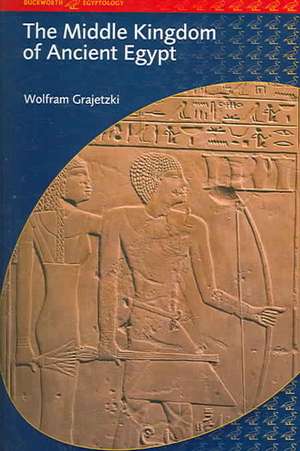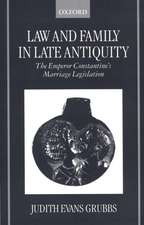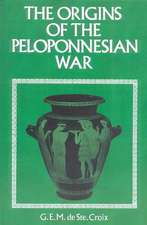The Middle Kingdom of Ancient Egypt: History, Archaeology and Society: BCP Egyptology
Autor Wolfram Grajetzkien Limba Engleză Paperback – 23 feb 2006
| Toate formatele și edițiile | Preț | Express |
|---|---|---|
| Paperback (2) | 148.29 lei 22-36 zile | +17.88 lei 6-12 zile |
| Bloomsbury Publishing – 12 iun 2024 | 148.29 lei 22-36 zile | +17.88 lei 6-12 zile |
| Bloomsbury Publishing – 23 feb 2006 | 257.97 lei 43-57 zile | |
| Hardback (1) | 407.93 lei 43-57 zile | |
| Bloomsbury Publishing – 12 iun 2024 | 407.93 lei 43-57 zile |
Preț: 257.97 lei
Preț vechi: 331.42 lei
-22% Nou
Puncte Express: 387
Preț estimativ în valută:
49.36€ • 51.67$ • 41.09£
49.36€ • 51.67$ • 41.09£
Carte tipărită la comandă
Livrare economică 31 martie-14 aprilie
Preluare comenzi: 021 569.72.76
Specificații
ISBN-13: 9780715634356
ISBN-10: 0715634356
Pagini: 208
Ilustrații: 1
Dimensiuni: 156 x 234 x 18 mm
Greutate: 0.39 kg
Editura: Bloomsbury Publishing
Colecția Bristol Classical Press
Seria BCP Egyptology
Locul publicării:London, United Kingdom
ISBN-10: 0715634356
Pagini: 208
Ilustrații: 1
Dimensiuni: 156 x 234 x 18 mm
Greutate: 0.39 kg
Editura: Bloomsbury Publishing
Colecția Bristol Classical Press
Seria BCP Egyptology
Locul publicării:London, United Kingdom
Caracteristici
Until now, the Middle Kingdom has too often overshadowed by the better-preserved architecture of other periods,
Notă biografică
Wolfram Grajetzki has participated in excavations in Egypt and Pakistan and has taught Egyptology at Humboldt University, Berlin. He is the author of several books including Burial Customs in Ancient Egypt (2003) and studies of Tarkhan and Harageh.
Cuprins
Preface List of Illustrations Introduction 1. History 1.1. The end of the Old Kingdom 1.2. The Heracleopolitan kings (c. 2161/2131-1990/1970 BC)1.3. The early Eleventh Dynasty at Thebes (pre-2065-2008 BC) 1.4. The second part of the Eleventh Dynasty (c. 2008-1938 BC) 1.5. The early Twelfth Dynasty (c. 1938-1837 BC) 1.6. The late Twelfth Dynasty (c. 1837-1759 BC) 1.7. The Thirteenth Dynasty (c. 1759-1685 BC) 2. Archaeology and Geography 2.1. Upper Egypt 2.2. Lower Egypt 2.3. The neighbouring lands 3. Society 3.1. Outside the ruling classes 3.2. The ruling classes: people with administrative titles 3.3. The king and his family Chronology Appendix A. Kings of the Middle Kingdom B. Viziers of the Middle Kingdom C. Treasurers of the Middle Kingdom Notes Further Reading Bibliography Illustration Sources Index
Descriere
For the ancient Egyptians, the Middle Kingdom (c 2000-1700 BC) was a classical period of art, history and literature. This book examines the evidence for the culture, history and society of both central and provincial Egypt at the time, revealing the wealth of the entire country.
Recenzii
This book provides an important update on the earlier, popular version. It is unique and impressive in its scope covering many aspects of Middle Kingdom administration and society drawing on a detailed survey of the evidence from all parts of Egypt. Critically, it does not favor one source type over others and draws on textual, artistic and archaeological sources equally. In doing so it addresses the Middle Kingdom society in a holistic and comprehensive manner.
An approachable, and well-rounded, introduction to the rich historical and archaeological record of Egypt's Middle Kingdom, one of the great, but often overlooked, eras of pharaonic civilization.
The Middle Kingdom of Ancient Egypt provides a clear and succinct summary of the complexities of political, social and religious aspects of one of the most intriguing periods in ancient Egyptian history, outlining the flexibility of power and socio-economic organization between 'king' and the many individuals in the provinces and frontiers.
An approachable, and well-rounded, introduction to the rich historical and archaeological record of Egypt's Middle Kingdom, one of the great, but often overlooked, eras of pharaonic civilization.
The Middle Kingdom of Ancient Egypt provides a clear and succinct summary of the complexities of political, social and religious aspects of one of the most intriguing periods in ancient Egyptian history, outlining the flexibility of power and socio-economic organization between 'king' and the many individuals in the provinces and frontiers.


















